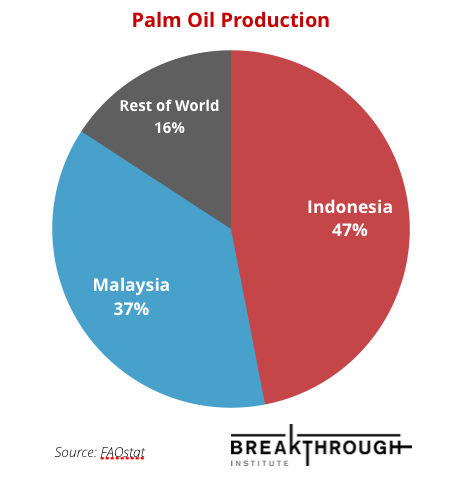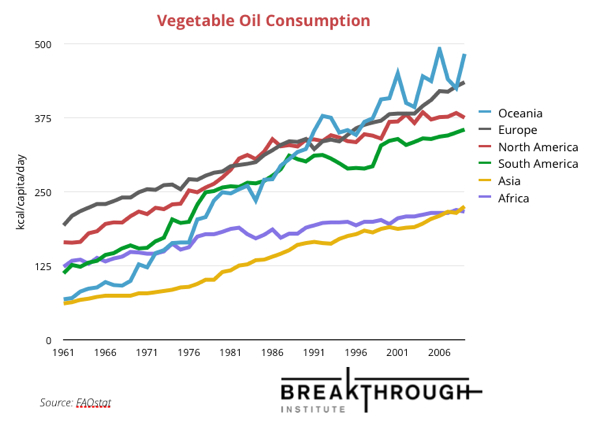Can Palm Oil Deforestation Be Stopped?
Why Only Sustainable Intensification Can Save Indonesia's Forests
-
-
Share
-
Share via Twitter -
Share via Facebook -
Share via Email
-
There has been growing interest among environmentalists and the public in recent years about palm oil and its role in tropical deforestation. Most recently, the new Showtime series Years of Living Dangerously features palm oil plantations in Indonesia as one of its main narratives, explaining how carbon emissions from deforestation are a driver of climate change. Celebrity correspondent Harrison Ford gapes from a helicopter, looking down at the swaths of palm oil plantations that have replaced tropical forest.
But what is really going on with palm oil? Why has there been such a boom in production, and how has it contributed to deforestation? More importantly, what can we do about it? A Breakthrough Institute analysis reveals there is no quick fix.
What do I need to know about palm oil?
Globally, 50 million tonnes of palm oil were produced in 2012 – nearly 15 pounds per person.1 Since the 1980s, world production of palm oil has increased more than ten-fold,2 and it is currently the most produced and traded vegetable oil in the world.3
Most palm oil (about 80 percent) is consumed in food products, both as a cooking or frying oil and as an ingredient in processed foods.4 It is a startlingly ubiquitous ingredient present in about half of the packaged foods on grocery store shelves, including margarine, baked goods, cookies, and crackers.5 Palm oil is also used for a variety of non-food products, including detergents, soaps, shampoos, cosmetics, and pharmaceuticals. In the last decade or so, palm oil has also been used as a biofuel, although palm oil still represents only 5 percent of global biodiesel production.6
Almost half of all palm oil consumed globally is grown in Indonesia, with Malaysia contributing another 37 percent (see Figure 1).
Figure 1.

How is palm oil contributing to deforestation?
Indonesia has one of the highest rates of deforestation in the world (second only to Brazil): the country lost an average of 820,000 hectares of tropical forest each year between 2000 and 2010, totaling an area the size of South Carolina.7 Palm oil’s exact role in this deforestation is difficult to quantify, but it is estimated that palm oil plantations are responsible for 11 to 16 percent of Indonesia’s forest loss in the last two decades.8,9 Producers clear an area of tropical rainforest, often using the profits from logging the area to cover the initial costs of establishing the palm oil plantation.10 Palm area plantations currently cover about 4.1 million hectares of land in Indonesia, and Koh and Wilcove (2008) found that 56 percent of oil palm expansion in Indonesia between 1990 and 2005 occurred at the expense of natural forests.
The loss of Indonesian tropical and peat forests is a double whammy for the environment. Firstly, it contributes to climate change: trees give off their stored carbon dioxide when they are cut down and burned. Similarly, carbon-rich peat soils which are found in Indonesia’s tropical forests also release carbon dioxide when they are burned or drained.11 Emissions from forestry and land-use change are Indonesia’s main source of GHG emissions, accounting for almost 60 percent of the country’s total emissions and placing it in the top ten of global emitters.12 Secondly, the loss of Indonesia’s tropical forests create a huge risk for biodiversity. Indonesia’s forests are home to some of the world’s richest biodiversity, providing a habitat for unique and endangered species like orangutans, tigers, and elephants.13
Can we just stop using palm oil?
If palm oil is driving deforestation in Indonesia, can we just use something else instead? A Greenpeace spokesman suggested to NPR that “people who buy products have plenty of alternatives to palm oil. There’s a lot of products out there that don't contain palm oil. They taste just as good; it works just as well.”14 Vaclav Smil, an emeritus environmental scientist from the University of Manitoba, noted to the audience at the Breakthrough Dialogue last June that "we are laying waste to Indonesia, burning the forests so we can put palm in place. Why? Because you want to eat cookies. You don't have to eat so many cookies.”15
Unfortunately, the reality of avoiding palm oil is a lot more difficult. Given that it is found in about half of all products on grocery store shelves, it is not as simple as avoiding one brand or even type of product.16 Vegetable oils are present even in vegan diets. Although there are alternatives to palm oil, other vegetable oils like soy or canola all come with their own set of problems and trade-offs.
How does palm oil compare to its substitutes?
Firstly, palm oil is cheaper than competitor vegetable oils (see Figure 2), and it has maintained a discount over its closest competitors – soy and sunflower oil – for several decades.17
Figure 2.

Secondly, palm oil has also become dominant in the food industry for its versatility and chemical characteristics. Palm oil is odorless, tasteless, and, unlike soybean or rapeseed (canola) oil, it does not require hydrogenation to achieve a solid state.18 Because of this property, it does not contain trans fat, a type of fat that has become unpopular in the food industry because of its health risks.19 Trans fats are now banned in several Western countries including the United States, and the shift away from trans fat propelled palm oil to replace soybean oil as the dominant vegetable oil globally.20
Thirdly, and most importantly for the environment, oil palm trees also produce much more oil per hectare than other oil crops (see Figure 3). They also have the lowest input requirements for fuel, fertilizer, and pesticides per tonne of production.21 Soybean oil, for example, requires 6 times more energy, 7 times more nitrogen, and 14 times more pesticides per tonne produced than palm oil.22
Figure 3.

Palm oil’s high yields mean it has a land-sparing effect compared to the alternatives. Agricultural expansion drives deforestation and biodiversity loss, so if we want to spare more land for nature, conservationists need to focus on growing more on less land. Replacing palm oil with more land- and input-intensive vegetable oils could be counter-productive, depending on where the expansion would occur. For example, the World Bank estimates that meeting vegetable oil demand in 2020 would require 6.3 million hectares of oil palm plantation; using soybean oil instead would require an additional 42 million hectares (an area about the size of California!)23
Palm oil production is taking place in areas of high biodiversity and carbon stock, but oil palm trees produce oil much more efficiently than the alternatives. This puts us between a rock and a hard place: we want to spare as much of Indonesia’s primary forest as possible, but vegetable oil demand must be met somehow, and palm oil is the most efficient way to produce it.
What about creating forest protected areas?
Deforestation for palm oil plantations persists in Indonesia even in officially protected areas and despite the government’s moratorium on deforestation.24 A study by Curran et al (2004) determined that official forest protected areas did not offer protection against deforestation in Indonesia, and the Ministry of Forestry itself found evidence of illegal deforestation occurring in 37 of 41 national parks.25
This fits with findings in the scientific literature that protected areas can rarely stand up to a strong economic pressures. Mascia & Pailler (2011) analyzed the status of protected areas around the world and found 89 instances of protected areas that have been downgraded, downsized, or degazetted since 1900. The main pressures leading to the degradation of protected areas were economic: removing protection to develop infrastructure, allow industries to extract natural resources, or to make room for human settlement.
Is Indonesia benefitting from palm oil?
For Indonesia, a rapidly developing country, the economics of palm oil are compelling. The palm oil industry in Indonesia generated about $12.4 billion in foreign exchange and at least $1 billion in export tax for Indonesia in 2008.26 It is Indonesia’s largest agricultural export27 and its most valuable non-oil and gas export.28
In addition to national income, the palm oil industry employs about 2 million Indonesians.29 In a country where 30 million people live below the poverty line, the role of industry in lifting people out of poverty is significant.30 The World Bank explains that oil palm provides more jobs per hectare than other large scale farming (it employs about 0.4 people per hectare), and the jobs are year-round rather than seasonal.31,32
A study by Sumatro and Suryahadi (2004) found that agricultural GDP growth of 1 percent annually reduced total poverty by 1.9 percentage points.33 An Indonesian development expert explained, “The government sees dollars earned through palm oil export as one of the means of raising the standard of living for Indonesians as a whole."34
For a developing country, the economic benefits of palm oil are difficult to ignore in favor of environmental protection. The Showtime series presents government corruption as the main reason that deforestation continues, blaming the Minister of Forestry and the Indonesian President for failing to enforce their laws against deforestation. But unfortunately the answer is not so simple. Indonesia’s desire for economic development is the real reason that palm oil presents such a compelling case against forest conservation. Given Indonesia’s desire to become a developed country, it is likely that deforestation for palm oil would continue even if all government corruption could be eliminated (although without corruption, more of the profits might remain in the country and be better distributed).
What is the outlook for palm oil?
Global production of vegetable oils is expected to increase 28 percent by 2023, with palm oil still providing the largest share.35 Although a significant amount, it is at least a slower projected rate than the recent past: palm oil demand almost doubled between 2002 and 2012.
This growth fits into a broader trend of increasing demand for vegetable oils globally (see Figure 4). Part of this increase in demand is due to falling vegetable oil prices, making diets higher in fat available to consumers at lower income levels.36 Popkin (2003) found that in 1962 an average GNP of $1475 was necessary to consume a diet with 20 percent of energy from fat, while by 1990 the GNP needed for a 20 percent fat diet was only half that at $750.
Figure 4.

Looking forward, Drewnowski & Popkin (1997) see a global trend converging on a diet deriving 30-35 percent of energy from fat. Countries with a GDP per capita over about $15,000 have generally achieved this “nutrition transition” to a high-fat, diverse diet, but there are still many developing countries that have not. The average European, for example, consumes almost twice as much vegetable oil as the average Asian.
Demand for vegetable oil has been rising even in rich countries whose diets are otherwise stable. However, as with any food item, there is a physical limit for how much people can consume in a day. So the key question is, until we reach a saturation point, how can we meet rising demand for vegetable oil in the least environmentally destructive manner?
Can we meet demand and spare forests?
Palm oil, with its high yields and low price, is “well-placed” to meet much of the increase in vegetable oil demand in the coming decades, according to the FAO.37 To ensure that this does not seal the fate of the rest of Indonesia’s tropical forests, producers and government need to work together to ensure the sustainable intensification of palm oil production in the country.
Indonesia’s government has joined forces with industry and non-profits to guide this transition. The Roundtable on Sustainable Palm Oil (RSPO), a non-profit stakeholder collaboration, was founded in 2004 to provide third-party certification of sustainable production. RSPO’s certification scheme has worked to enforce anti-deforestation measures and promote production on already degraded lands. When palm oil is grown on open areas or already degraded land, it can actually offer net carbon savings.38
There is significant potential for Indonesia to increase palm oil production without clearing new land for plantations. Potential for yield improvements is especially high on smallholder farms, which account for 44 percent of Indonesian palm oil plantations.39 Smallholders’ yields are often less than half of yields from large-scale producers, and access to capital, good planting material and other agronomic practices can help increase production on these farms.40 Future developments also offer promise: research into genetically modified plants could create shorter oil palm trees that live longer than the typical 25 year lifespan, which would reduce the need for removal and replanting of trees and increase the frequency of harvests.41
Brazil has seen success following the intensification model to decrease deforestation in the Amazon. Increasing access to rural credit tied to compliance with environmental regulation has shown to be an effective model at increasing agricultural productivity on existing farmland and preventing forest clearing for cropland expansion.42,43 Balmford et al (2005) found that increases in yield were as important as demand in determining expansion of crop area. This again highlights the importance of increasing yields as a lever in preventing deforestation for agricultural expansion.
What’s the long and short of it?
By acknowledging the economic benefits of palm oil to Indonesia, we can focus on increasing yields to produce more without pushing plantations deeper into forest area. Palm oil in Indonesia is a wicked problem, but it is one that can benefit from a rational assessment of its drivers.
FAOstat (2014). FAOstat Database: Production Quantity, Palm Oil. http://faostat3.fao.org/download/Q/QD/E
FAOstat.
Sheil et al. (2009) "The impacts and opportunities of oil palm in Southeast Asia: What do we know and what do we need to know?” CIFOR Occasional Paper No. 51 http://www.cifor.org/publications/pdf_files/OccPapers/OP-51.pdf.
World Bank/IFC (2011) "The World Bank Group Framework and IFC Strategy for Engagement in the Palm Oil Sector" http://www.ifc.org/wps/wcm/connect/159dce004ea3bd0fb359f71dc0e8434d/WBG+Framework+and+IFC+Strategy_FINAL_FOR+WEB.pdf?MOD=AJPERES.
WWF (2014) “Palm Oil: Productive and Versatile." http://wwf.panda.org/what_we_do/footprint/agriculture/palm_oil/about/.
Sheil et al.
Stibig et al (2013). Change in tropical forest cover of Southeast Asia from 1990 to 2010, Biogeosciences, 11, 247-258.
Abood et al (2014). “Relative contributions of the logging, fiber, oil palm and mining industries to forest loss in Indonesia.” Conservation Letters.
Fitzherbert et al (2008). How will oil palm expansion affect biodiversity? Trends in Ecology & Evolution, 23(10), 538–45.
Sheil et al.
EPA (2014) “Global Greenhouse Gas Emissions Data.” http://www.epa.gov/climatechange/ghgemissions/global.html.
WRI (2014). Climate Analysis Indicators Tool (CAIT 2.0). http://cait2.wri.org/wri/.
Sodhi et al (2004). Southeast Asian biodiversity: an impending disaster. Trends in Ecology & Evolution, 19(12), 654–60.
NPR (2008) “Worse Than Crude: The Case Against Palm Oil.” http://www.npr.org/templates/story/story.php?storyId=90714122.
quoted in Biello, D. (2013) "How to Survive as a Biofuel-Maker: Sell Algae to Bakers [Slide Show]” http://www.scientificamerican.com/article/how-to-survive-as-former-algae-biofuel-maker-solazyme/.
WWF.
Thoenes, P. (2006) "Biofuels and Commodity Markets – Palm Oil Focus.” FAO Commodities and Trade Division. http://s3.amazonaws.com/zanran_storage/www.rlc.fao.org/ContentPages/15778750.pdf.
Thoenes (2006).
Aubrey, A. (2013) "Palm Oil In The Food Supply: What You Should Know.” NPR. http://www.npr.org/blogs/thesalt/2013/07/25/205486197/palm-oil-in-the-food-supply-what-you-should-know.
Aubrey (2013).
World Bank/IFC.
Teoh, C. H. (2004) “Selling the Green Palm Oil Advantage?” Oil Palm Industry Economic Journal 4:1. http://palmoilis.mpob.gov.my/publications/OPIEJ/opiejv4n1-teoh.pdf.
World Bank/IFC.
MacLean, D (2014) "Palm oil fuels Indonesia deforestation.” Al Jazeera. http://www.aljazeera.com/indepth/features/2014/04/palm-oil-fuels-indonesia-deforestation-indigenous-displa-201443145636809366.html
Sheil et al.
Obidzinski, K. (2013) "FACT FILE – Indonesia world leader in palm oil production.” Forests News (CIFOR) http://blog.cifor.org/17798/fact-file-indonesia-world-leader-in-palm-oil-production#.U03GxuZdWoU.
Obidzinski (2013).
Bahroeny, JJ (2009) "Palm oil as an economic pillar of Indonesia” Jakarta Post. http://www.thejakartapost.com/news/2009/12/02/palm-oil-economic-pillar-indonesia.html.
Sheil et al.
Obidzinski 2013.
World Bank/IFC.
Obidzinski 2013.
Cited in Asian Development Bank (2006). Indonesia: Strategic Vision for Agriculture and Rural Development. http://www.adb.org/sites/default/files/pub/2006/Strategic-Vision-Indonesia.pdf
MacLean, D (2014) "Palm oil fuels Indonesia deforestation.” Al Jazeera. http://www.aljazeera.com/indepth/features/2014/04/palm-oil-fuels-indonesia-deforestation-indigenous-displa-201443145636809366.html.
OECD-FAO (2014). OECD-FAO Agricultural Outlook 2014: Chapter 5, Oilseeds and Oilseeds Products. http://www.keepeek.com/Digital-Asset-Management/oecd/agriculture-and-food/oecd-fao-agricultural-outlook-2014/oilseeds-and-oilseed-products_agr_outlook-2014-8-en#page7
Drewnowski & Popkin (1997). The nutrition transition: new trends in the global diet. Nutrition Reviews, 55(2), 31–43.
Thoenes 2006.
Sheil et al.
World Bank/IFC.
Sheil et al.
Sheil et al.
Lapola et al (2013). Pervasive transition of the Brazilian land-use system. Nature Climate Change, 4(1), 27–35.
Rocha, R. (2011). Deforestation Slowdown in the Legal Amazon: Prices or Policies? Climate Policy.
References
Arga, A. (2007). “Indonesia world’s No. 3 greenhouse gas emitter: report.” Reuters. http://www.reuters.com/article/2007/06/04/environment-climate-indonesia-dc-idUSJAK26206220070604.
Balmford et al (2005). Sparing land for nature: exploring the potential impact of changes in agricultural yield on the area needed for crop production. Global Change Biology, 11, 1594–1605.
Curran et al (2004). Lowland Forest Loss in Protected Areas of Indonesian Borneo. Science 303 (5660), 1000–1003.
Koh & Wilcove (2008). Is oil palm agriculture really destroying tropical biodiversity? Conservation Letters, 1(2), 60–64.
Mascia, M. B., & Pailler, S. (2011). Protected area downgrading, downsizing, and degazettement (PADDD) and its conservation implications. Conservation Letters, 4(1), 9–20.
Popkin, B. M. (2003). The Nutrition Transition in the Developing World. Development Policy Review, 21(5-6), 581–597.
